|
SpaceTides e-zine
#53 – April 2007
Internet
Newsletter of ASSA Bloemfontein Centre, South
Africa, to the public
www.assabfn.co.za/spacetides

|
Subscribe to the free SpaceTides e-zine by
sending an e-mail to spacetides@assabfn.co.za
with the word "Subscribe" in the subject line if you are not
already subscribed. |
In this issue of SpaceTides |
INDEX
Double click on
this email in your inbox to open it in a full window
1. Spaceflight
news from around the world
2. Astronomy news from around the world
3. The Solar System: The tilted Uranus
4. Sky Observation log: April 2007 night skies
5.
Special feature: What is spectroscopy?
6. Photo Sense: Surrounded by Lightning
in Sutherland
7. SA Astronomy: Reminder, Scope-X on 21 April 2007 in JHB
___________________________________________________________________________________________
Dear
SpaceTides Subscribers
The April and May 2007 editions of SpaceTides will be scaled-down versions due to increased work responsibilities on the editor's part for these two months.
Spectroscopy is something not well known in
the public eye, although it plays such a fundamental role in astronomy. I've
read up on the concept and tried to put it in simple terms in this issue.
It's even something that the amateur astronomer can do.
Regards,
Gerrit Penning
Editor
Total subscribers as at 1 April 2007: 739 (+6 from previous
issue #52) |
1. Spaceflight news from around the world |
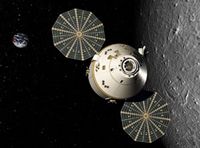 Artist's concept of the Orion crew vehicle in lunar
orbit. Artist's concept of the Orion crew vehicle in lunar
orbit.
Credit: Lockheed Martin Corp.
|
The risks in human missions to Mars
Inspired by an
article on the NASA.gov
website
Using the International Space Station as testbed and building an
outpost on the Moon will be critical to prepare for a future manned
mission to Mars. NASA is planning to send people back to the Moon,
using a new spacecraft called the Orion Crew Vehicle.
Currently there are major risks associated with humans going to Mars. A
mission will last a minimum of 3 years due to the positions of Earth and Mars
in their orbits. During this time astronauts will face a daunting array of
risks, including cancer from harmful solar radiation (even if they wear
spacesuits!), bone and muscle loss from a low-gravity environment as well as
a possible shortage of oxygen, food and fuel supply.
By performing experiments on the space station, and building a base on the
Moon, astronauts and scientists can slowly start to address the above risks
to ensure a safe journey to Mars. More risks at spacescan.org |
2. Astronomy news from around the world |
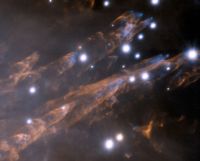
This image
shows the Orion "bullets" as blue features and represents the light
emitted by hot iron (Fe) gas. Credit: Gemini
|
Gemini's Laser Vision
Reveals Striking New Details in Orion Nebula
Gemini
Observatory news release, 22 March 2007. Read full
article.
The Gemini Observatory brought into focus a new and remarkably detailed view
of supersonic "bullets" of gas as they pierce through clouds of
molecular hydrogen in the Orion Nebula. The image was made possible
with new "laser guide star" adaptive optics technology that
corrects in real time for image distortions caused by Earth's atmosphere. Space-based
telescopes like the Hubble has a major advantage over Earth-based telescopes,
as they do not need to "see" through Earth's turbulent atmosphere.
With adaptive optics however, Earth-based telescopes now have a sporting
chance.
The Orion Nebula is a star-forming region located relatively near to us,
about 1,500 light-years away. It's a young stellar nursery and shows many
unusual features related to the effect of massive stars on the dense birth
environment of gas and dust.
These gigantic "bullets" are speeding outward from the cloud at up
to 400 kilometers per second. This is more than a thousand times faster than
the speed of sound. |
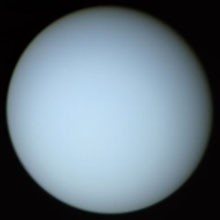
The planet Uranus as photographed by the Voyager 2 space
probe. NASA
|
The
tilted planet Uranus
Uranus is the 7th planet from the Sun and the 3rd largest in the solar system.
It was the first planet to be discovered in modern times, by Sir William
Herschel in 1871.
Uranus has a peculiar characteristic: it has an extreme axial tilt. The planet
lies virtually on its side, at a 98 degrees angle. Each pole receives 42
years of direct sunlight and then 42 years of total darkness, during the
planet's orbit around the Sun.
Uranus's atmosphere is mostly composed of gas and ice. The gas consists primarily of hydrogen, a
smaller amount of helium and a much smaller amount of methane. The methane is
responsible for giving Uranus its distinct blue colour due to the absorption
of red light by the methane molecules. A number of clouds in the upper
atmosphere have been observed.
Uranus also has a very faint ring
system. It was discovered from Earth in 1977 and was
confirmed during the Voyager 2 satellite fly-by in 1986. It consists
primarily of 'icy' materials such as water, methane, and ammonia, with
higher-density rocky materials deeper in. More at Wikipedia. |
This is the 8th part in a 12-part series about the Solar System.
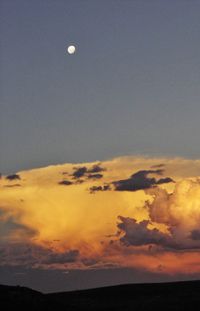
The Moon over the Karoo, in late March 2007. |
Planets
- April 2007
Mercury is visible in the morning skies,
rising in the constellation of the Fish at about 5h00. Venus shines bright in the
evening skies just after sunset in the west. Mars rises in the morning skies in Aquarius at
around 3h00. Jupiter can be seen from 22h00 rising below Scorpius. Saturn can be seen in the evening skies, until about
midnight, between Leo and Cancer. Uranus and Neptune are
morning objects, but you need a binocular/telescope to see them. Anyone seen
that pesky little planet Earth? Apparently it's been speeding around a
star called "Sun", somewhere near the Orion arm of the Milky Way
galaxy. It is wanted for questioning by the galactic police in conjunction
with some crazy false UFO reports generated by its inhabitants...
Constellations - April 2007
It's now the time to observe Leo, the larger Lion, in the northern
skies in the evenings. Leo lies on its back for us in the southern
hemisphere. It looks like an Egyptian sphinx seen from the side. The bright
object close to its front paw is the planet Saturn.
The Southern Cross is rising in the south-east. The Pointers (Alpha
and Beta Centauri) is situated below it. Above and to the right of Crux you
will find the Diamond, actually stars belonging to the constellation Carina.
Above the Diamond you will see the False Cross - somewhat larger than the
real cross. Seasoned observers should try to see the giant boat Argo in this
vicinity, consisting of the 4 constellations Carina, Vela, Puppis and Pyxis.
Once you've seen Jason's boat, you may travel with him and his Argonauts to Colchis in search of the golden fleece. Seeing Argo is a challenge, but's its worth the
effort.
Deep Sky Objects
in Carina for binoculars and telescopes - April 2007
NGC 3372 (Keyhole nebula/Eta Carina). NGC 3532 (Wishing Well open cluster)
NGC 3114 open cluster, IC 2602 (Southern Pleiades). NGC 2516 open cluster |
Other
celestial events - April 2007
Comet 2007 E2 Lovejoy: a new comet is visible in the southern skies, although in the
mornings. It was discovered by the Australian Terry Lovejoy on 15 March 2007,
after more than 1000 hours of diligently photographing the night sky. During April the comet moves
northward through Sagittarius and Aquila, and is well placed for observation
by binocular. It will most probably not become visible enough for the unaided
eye. The comet makes its closest approach to earth on April 24, when it
will still be a morning object, transiting at around 5am. Finder charts:
http://www.yp-connect.net/~mmatti/
Lovejoy ephemeris: http://cfa-www.harvard.edu/iau/Ephemerides/Comets/2007E2_1.html
Full Moon on 2 April 2007
New Moon on 17 April 2007
More event information on the ASSA website: http://assa.saao.ac.za and in the 2007 Sky Guide.
Deep Sky Delights for April is now available - discover hidden
treasures in the Southern Cross. Download 400
kb PDF. |
5. Special Feature: Spectroscopy |
Using Spectroscopy to study the Stars
How is it possible that astronomers can tell us what kind of elements stars
consist of and how hot they are? We can't even touch it and we haven't even
sent satellites there!
Well, it's all about light waves. By analyzing the radiation received from
stars, astronomers can use a technique called "spectroscopy" to
conclude with accuracy what the stars consists of. They can even tell its
temperature, density and motion.
The clue lies in fingerprinting. Each element (e.g. oxygen, hydrogen, helium
and other forms of matter) have its own unique spectrum of light, like
a fingerprint. Stars consists of these gasses and emit light waves. By using
a spectrometer, astronomers can analyze the light waves into its
different parts and because each gas gives off a unique spectrum, they can
easily tell what kind of gasses are present in the star.
A substance will emit spectral lines (at a particular wavelength) when
it is heated, and absorb light at the same wavelength when it
is cool. When the substance emits light, an emission spectrum
is generated. When the substance absorbs light (at the same
characteristic wavelength), the spectral pattern that is formed is called an absorption spectrum.
For example, burning sodium will always produce two very close yellow
lines (near the middle of the spectrum) on a black background, and it is the only
element that will do exactly this. If you analyze light waves from a star
and find these characteristic yellow lines, you know that there was sodium in
the star that produced this light. And, if you look at a light source and
find dark lines in the same place on the spectrum, you know that the
light you're seeing passed through sodium gas somewhere on its journey
to you. Obtained from Enchanted
Learning.
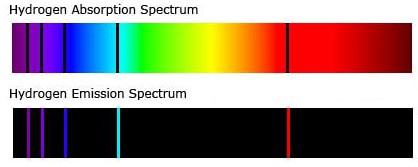
The
unique spectrum of hydrogen gas. Our Sun consists mostly of hydrogen.
The visible layers (the photosphere and the chromosphere) is the only part of
the Sun that is cool enough for hydrogen to exist in its atomic form and it
is here that we can see the absorption and emission spectra for hydrogen. From:
http://www.solarobserving.com/halpha.htm |
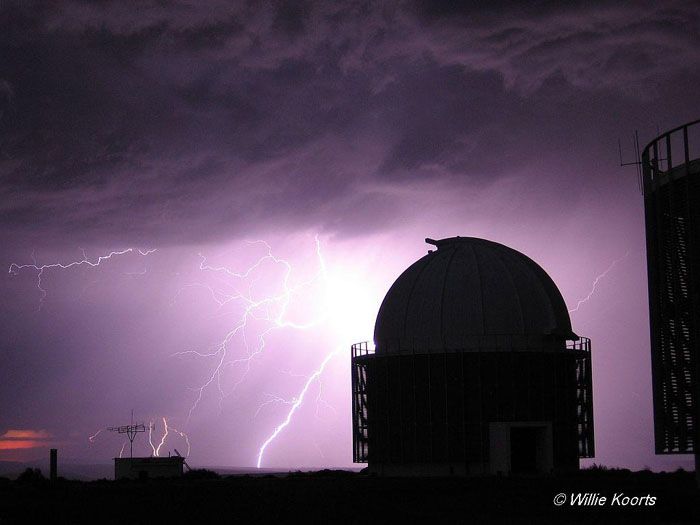
Photographer: Willie Koorts (SAAO). Date picture taken: 2 April 2007. Location: SAAO, Sutherland.
Description:
"When I went up to the domes at sunset last night, there were
thunderstorms almost 360 degrees [around me]. I plonked down my camera on a
mini tripod and as it got darker, I could expose for longer and longer, ending
up taking sequences of 15 second exposures, in the hope of catching a nice
strike with a dome on the foreground." (5 images were stacked in total)
|
7. SA Astronomy: Scope-X on 21 April 2007 |

Scope-X in Johannesburg on 21 April 2007
The well-known annual telescope and astronomy expo called Scope-X,
organized by the Johannesburg Centre of ASSA, will take place on Saturday, 21
April 2007 in Johannesburg. Download PDF Information brochures in Afrikaans
or English by visiting the Johannesburg
Centre's website.
Main theme: Astrophotography. International guest speaker Richard
Berry from the USA will deliver the keynote talk. You can also
attend a special dedicated workshop on 20 April presented by Richard.
|
|



